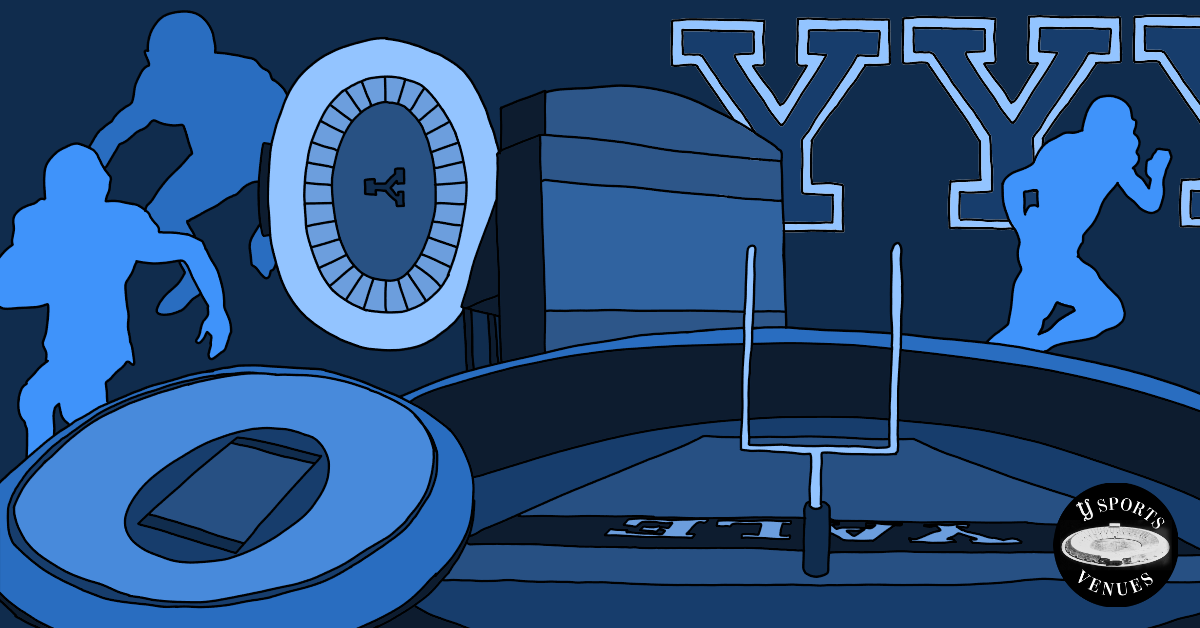Behind the Venue: The Yale Bowl and a game one hundred years in the making
Opened over a century ago in 1914, the Yale Bowl has since been lauded as both an architectural landmark in American sports and a college football treasure. As part of a season-long celebration of the Bowl’s 100th birthday back in 2014, Team 142’s rivalry with Army was finally renewed after a nearly 20-year hiatus.

Anasthasia Shilov, Illustrations Editor; Zully Arias, Production and Design Editor
“Behind the Venue” is a series of feature-form articles that dives into the history, character and most memorable moments of Yale’s various athletic forums — from stadiums and fields to pools and boathouses. While not all articles in the series will resemble one another, all attempt to take a deeper look into how these places came to be and how they have fared over time. This article is the seventh in the series.
On sunlit Saturday afternoons in the fall, roughly a mile and a half off of Yale’s main campus, the time-honored congestion of once trolleys, now cars, stuffing the northbound Derby Avenue all the way to Walter Camp Memorial Gateway has been an unfaltering tradition for over a hundred years. It is a ceremonial traffic jam that has come to represent New Haven’s ritualistic display of fandom for Yale football and the stadium that the team calls home: the Yale Bowl.

Early Beginnings
The conceptualization of the Bowl, the second-oldest active collegiate football stadium in the country, dates back to 1913, when a mandate was given to a Yale committee to provide revamped and refined athletic venues in order to give the student body abundant athletic and recreational opportunity.
Back then, it was clear that the Yale football team — which, having not experienced a losing season in its then 40-year history, was one of the premier programs in the country — had grown too large for its wooden, insufficiently seated stadium, the Yale Field. Thus, an 85-acre plot of land just across the street from the Field was bought by the committee as it formulated plans for a new stadium capable of holding massive crowds. However, the committee eventually settled on design plans not for a stadium, at least in the traditional sense of the word, but for a bowl. The field would be situated within a completely enclosed stadium, the likes of which had never before been seen in the United States.
Ground was broken, both figuratively and literally, in the summer of 1913, when builders excavated a hole in the ground in the shape of the field. They then used the dirt and soil they had dug up to build up a berm — a ridge constructed of compacted soil designed to divert water away from a particular area — around the perimeter, giving the Bowl its now-signature dish-like shape. When construction finally finished in 1914, the Yale Bowl was met with instant, widespread acclaim. Modeled after Roman amphitheaters while also echoing the neo-Gothic style of Yale’s very own campus, it was an engineering and architectural wonder that could hold 70,000 fans. The bowl-like shape itself was especially commended for how it provided audience members from any seat in the facility with an exceptional view of the field.
“We are so fortunate that we get to use [the Yale Bowl] for all of our practices,” current head coach Tony Reno said. “We were doing our workouts a few days ago, and as soon as those doors to the field open and you start walking down the tunnel, no matter what time of year it is … you get those butterflies in the stomach because you’re so excited to be back at the stadium. It’s a surreal place.”
In the century that followed, the design of the Bowl served as inspiration for many other now-iconic stadiums, such as the Rose Bowl, built in 1922, the Los Angeles Memorial Coliseum, built in 1923, Michigan Stadium, built in 1927, and the Cotton Bowl, built in 1930, to name a few. The term “bowl” had a noticeable influence on sport linguistics, as it has been used to describe both college championship games and one of the world’s most-watched annual sporting events — the Super Bowl.
The 1970s were an especially busy decade for the venue, which hosted the New York Giants for 12 games while Giants Stadium was being built. In 1975, Pelé played one of the final games of his soccer career on Yale Bowl sod. The Eagles, the Grateful Dead, the Who, Led Zeppelin and other legendary performers all rocked the Bowl, attracting tens of thousands in the process. The stadium even served as host for the 1995 Special Olympics World Summer Games.
Yet in a century crammed with enough sensational moments and historical occasions to fill a book, one year, one game, one afternoon stands out in particular. A perfect concoction of celebration and competition, harmony and rivalry, clanship and feud, it was a moment in Yale football history that has left an indelible mark on collegiate football lore.

Sept. 27, 2014: Army vs. Yale
1893 marked the first time that the Elis and the Black Knights faced one another, making their rivalry one of the oldest in college football. This matchup became a yearly tradition for nearly five decades, but between 1943 and 1996, these two schools only saw each other six times. This was mainly due to a 1945 decision in which the Ivy League presidents prevented the Ivy League football program from participating in the NCAA Division I Football Championship or any postseason action. This meant that games against Yale were not to be counted as bowl-eligible wins for any Football Bowl Subdivision school, Army included.
After a 39–13 shellacking at the hands of the Black Knights in 1996, the rivalry was brought to a halt until 2014, a year that marked the 100-year anniversary of the Yale Bowl. Managing to elude NCAA dictum, Yale acquired a waiver ensuring that a potential game against Army would be bowl-eligible.
“Since we’re a [Football Championship Subdivision] school, when I first heard rumblings that they were going to try to get Army to come to play [Yale] in the Bowl, I was, of course, a little bit skeptical,” Yale’s 2014 defensive coordinator Rick Flanders said. “However, when it was officially announced that the game was a go, in the months leading up to the fall, every person that I saw walking around New Haven was talking about the game. It was as if you had gone back in time 50 years. That’s what I imagine it was like half a century ago when Yale football was the biggest draw in the state of Connecticut.”
As part of Team 142’s season-long celebration of the Yale Bowl centennial, a September battle with Army was officially set to commence in New Haven. In a matchup poised to be a spectacular celebration of American football tradition more than anything else, the renewed rivalry between two talented, fierce foes more than lived up to expectations.
For Reno, it was unlike any other pregame he had experienced in his career.
“It was one of those really beautiful September days where there wasn’t a cloud in the sky,” he said. “I remember the pregame in particular, where I was standing on the sideline with a referee, and all of a sudden he looked at me said, ‘You don’t see that too often.’ I asked what he meant, and he told me to look back at the press booth, and I saw two snipers stationed in the box because Army had General Rodriguez in attendance for the game.”

The pregame festivities had kicked off the night before the game, akin to a Yale-Harvard matchup, with the bands of both schools performing at Woolsey Hall. The following Saturday morning, rather than an agglomerate of cars congesting Derby Avenue, close to 1,000 cadets crowded the road instead, marching in rows of four all the way from Marginal Drive past the Walter Camp Memorial Gateway and into the Bowl, all while bagpipers led the way.
Flanders recounts how, in the 19 seasons he spent coaching at Yale, he had never witnessed as many fans lined up outside the stadium as he did that day.
“A few years before Yale-Army, we started doing a ‘Bulldog walk’ from the arches down to the field,” Flanders continued. “On a typical Saturday you could expect to see some parents and a few drunk college students, but on that day, it was like going to the Macy’s Parade. Everyone was there so they could see the cadets come and walk through the arches. As good as the football game itself was, the atmosphere pre- and post-game completely out-shined it.”
The so-called “march on” is a tradition typically reserved for the Army-Navy rivalry. In fact, to Reno’s knowledge, “the Corps of Cadets never travel for any athletic reason except for the Navy game.” Yet, much to the delight of the Yale students adorned in red, white and blue who swarmed the Walter Camp Memorial Gateway that morning, the cadets made the nearly 100-mile trip east from West Point to be in attendance at the Bowl.

With Bulldogs and Black Knights fans alike beginning to settle into the stands, in another tradition typically reserved for Army home games at Michie Stadium, the game balls were parachuted into the venue by members of the Parachute Team. When the first cadets began making their descent onto the field, chants of “U.S.A.! U.S.A.!” echoed throughout the Bowl.
“For the audience, despite the game being adversarial to a certain extent, it certainly felt like this matchup was a celebration of American culture in a lot of ways,” former Team 142 running back Tyler Varga ’15 said.
The stage was now set for the Blue and White, the undeniable FCS underdog, to wage battle with FBS Army and its potent triple-option attack. Fittingly, both teams would rise to the occasion.
The squads exchanged touchdown blows twice in the first half before a last-minute Black Knights score handed the Elis a seven-point deficit going into halftime. With Army scoring a pick-six a minute into the second half, it appeared that Yale would be unable to go toe-to-toe with a Black Knights offense that had been as good as advertised.
The clubs traded touchdowns once more, but Team 142 managed to put together two consecutive touchdown drives to knot the score at 36 apiece. Three seconds into the fourth quarter, Army answered right back with a touchdown in a game that had officially reached barn-burner intensity.
A few cadets also started a flag relay during this fourth quarter, when one cadet took an American flag and began running with it around the inner concourse before handing it off to another cadet. After a few times around, a Yale student with a cape made out of the American flag ran alongside the cadet. Before long, a sea of children joined in as well.
“Every fan on both the home side and visitor side in the bleachers just started cheering like crazy as the cadets ran all the way around the Bowl,” Reno said when recounting the event.

There was still a game to be played, however, and Yale was in desperate need of a score. With fewer than two minutes left in regulation, Varga, who had been having his way with the FBS defense all afternoon, scored his fourth touchdown of the game to tie it at 43 — forcing overtime.
The Black Knights got the ball first in extra time, taking it all the way to the two-yard line. Yale summoned its biggest defensive stop of the day by forcing a fourth-down. Army’s ensuing field-goal attempt missed the uprights completely, which opened the door for the Bulldogs.
Six plays later, Varga saved his best score for last — bulldozing his way through several Army defenders to break the plane of the endzone, giving Yale the victory and tying a school record with five scores in a game in one fell swoop.

Yale 49, Army 43.
“There’s no question we were the definite underdog in that game,” Flanders said. “[Team 142] was a group of kids that liked being the underdog and liked having that chip on their shoulders, and it played into that game for sure. You’re very seldom going to win a defensive battle against a team like Army, especially when you’re the underdog. You have to find some ways to score more than you probably should, and we did.”
In 1987, the Yale Bowl was declared a National Historic Landmark by the federal government.
Jared Fel | jared.fel@yale.edu









